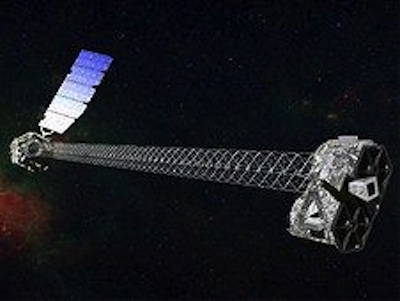Researcher helps NASA open a new window on the universe with cutting-edge NuSTAR
02 Jun 2012
NASA is making final preparations to launch its Nuclear Spectroscopic Telescope Array, NuSTAR. The mission, which will use X-ray vision to hunt for buried black holes, ultra-dense neutron stars, and supernova remnants, is scheduled to launch from Kwajalein Atoll in the central Pacific Ocean no earlier than 13 June.
 "We will see the hottest, densest and most energetic objects with a fundamentally new high-energy X-ray telescope that can obtain much deeper and crisper images than before," said Fiona Harrison, the NuSTAR's principal investigator at the California Institute of Technology in Pasadena, who first conceived of the mission 20 years ago.
"We will see the hottest, densest and most energetic objects with a fundamentally new high-energy X-ray telescope that can obtain much deeper and crisper images than before," said Fiona Harrison, the NuSTAR's principal investigator at the California Institute of Technology in Pasadena, who first conceived of the mission 20 years ago.
Victoria Kaspi is the Lorne Trottier Chair in Astrophysics, the Canada Research Chair in Observational Astrophysics and Professor of Physics at McGill University and is among the key NuSTAR team members. In her position of Galactic Science Team Lead, Kaspi is responsible for ensuring the new space telescope points at the most intriguing objects in the Milky Way.
''Planning observations with NuSTAR is like being a kid in a candy store,'' says Kaspi, ''black holes, neutron stars, supernovae – these are amazing objects that we'll soon see in an entirely new way.''
Kaspi and her McGill team look forward in particular to using NuSTAR to study, among other things, magnetars, the most highly magnetised stars known in the Universe.
NuSTAR will be the first space telescope to create focused images of cosmic X-rays with the highest energies. These are the same types of X-rays that doctors use to see your bones, and airports use to scan your bags. The telescope will have more than 10 times the resolution, and more than 100 times the sensitivity, of its predecessors operating in a similar energy range.
Studying black holes that are big and small, far and near, NuSTAR will endeavour to answer questions about the formation and physics behind these wonders of the cosmos. The observatory will also investigate how exploding stars forge the elements that make up planets and people, and it will even study our own sun's atmosphere.
NuSTAR is a Small Explorer mission led by the California Institute of Technology in Pasadena and managed by NASA's Jet Propulsion Laboratory, also in Pasadena, for NASA's Science Mission Directorate in Washington. The spacecraft was built by Orbital Sciences Corporation, Dulles, Va. Its instrument was built by a consortium including Caltech; JPL; the University of California, Berkeley; Columbia University, New York; NASA's Goddard Space Flight Center, Greenbelt, Md.; the Danish Technical University in Denmark; Lawrence Livermore National Laboratory, Livermore, Calif.; and ATK Aerospace Systems, Goleta, Calif. NuSTAR will be operated by UC Berkeley, with the Italian Space Agency providing its equatorial ground station located at Malindi, Kenya. The mission's outreach program is based at Sonoma State University, Rohnert Park, Calif. NASA's Explorer Program is managed by Goddard. JPL is managed by Caltech for NASA.






























